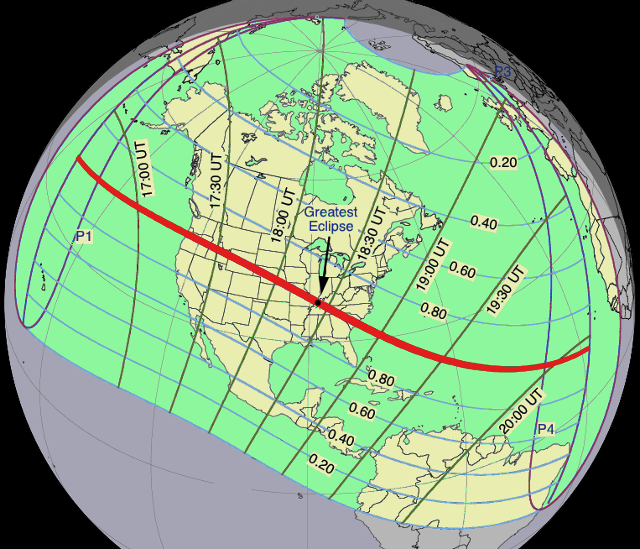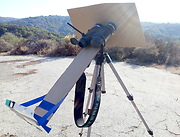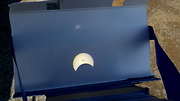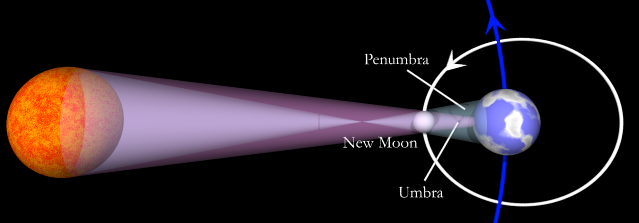Unfortunately, the news media are very bad at telling us about upcoming
eclipses. The usual thing is that they tell us a solar eclipse is
happening... tomorrow. Since it can takes weeks to order eclipse glasses,
plan school lessons, and so on, the sad result is that a lot of
people fail to get the best out of the amazing spectacle.
This site is here to help! The home page lists
prominent upcoming eclipses that you should consider planning for; and
the next 10 years page shows all
eclipses coming up in the next 10 years. And finally this page tells you
how you can make simple preparations to get the most out of
an eclipse. By researching the proper
place and time to see the eclipse, and by setting up some simple supplies
in advance, you can have a safe and enjoyable eclipse-watching experience.
The Date, Time and Place

Visibility of a typical total solar eclipse — be in the red band!
First of all, make sure you have the dates and times right; the headline
date of an eclipse is not necessarily the
date it happens on in your local time zone.
This site can show you all the timings of eclipses in your local time,
as long as you have
selected your time zone in the
settings; so do that, and then look at the detail page for the eclipse you're
interested in to get the timings listed for your time zone.
For lunar eclipses, the eclipse timings are the same for everyone in the
world. For solar eclipses, though, the overall timings are not the
time when the eclipse will be seen in your location. Eclipse pages will
usually give a more detailed breakdown of when the eclipse will be seen in
a given location, and the eclipse maps have markers showing the timings
for specific locations along the eclipse path.
The Observing page has advice on
the best place to be for a given eclipse — both in terms of which
parts of the world will see the eclipse, and also how you can find a good
viewing location in your area.
Lunar Eclipses
A lunar eclipse is relatively
easy to plan for. There's really no special equipment required, and as
long as you have a good view of the Moon, location isn't critical,
as the eclipse can be seen from half the Earth.
You're going to be out at night, so think about the cold — even when
the temperature isn't terribly low, when you're outside and relatively
inactive in the small hours of the morning, it can feel very cold. So
have warm clothes and a flask of something hot to drink.
Other than that, just enjoy the spectacle! If you're going to try to
photograph or video the eclipse, remember that the full Moon starts very
bright, then gets a lot dimmer during a total eclipse —
by 15 to 20 stops or so. And it moves faster than you might think; it
will move its own diameter in about 2 minutes.
Solar Eclipses
For any solar eclipse, the most
important thing to thing about is eye safety.
The precautions you need to take are pretty simple, and generally should
not stop you enjoying the eclipse; however, if you are not confident
that you, or people you are responsible for, can correctly follow the
safety precautions, then it would be
best to stay indoors and watch the event on TV or the internet.

A simple binocular-based eclipse
projector.
For the great majority of people, a solar eclipse is a fascinating phenomenon,
and should not be missed; so prepare in advance by having proper viewing
equipment set up. Eclipse glasses are the most basic, and these can easily
be found online. Just order them a few weeks in advance so that
you have them in time. Make sure to buy them from a reputable source —
fake goods of all kinds are abundant, and real eclipse glasses need to
block out 99.997% of the visible light.
A sun projector is a fantastic way to view a solar eclipse. Not only
is it a safe and fun way to see any non-total solar eclipse, building one
is an interesting project and a great opportunity for teaching basic optics and
engineering. Our Observing page has
information on various types of projector. Setting one of these up is quite
easy, as long as you have the materials and time to experiment in advance.

Projecting a partial Solar Eclipse and sunspot region.
A sun projector can be used for viewing the Sun at any time, and can be
used for viewing sunspots and active regions; so start experimenting
well in advance, and you'll be prepared for the eclipse. Just remember to
never look through the projector — only look at the
projected image.
Teaching
An eclipse of any kind is a great opportunity to get kids engaged with
the sciences, and to teach them about optics, engineering, and astronomy.
For a solar eclipse in particular, you obviously need to be prepared to
deal with the safety and logistical issues, and I hope this page is a
little help. Beyond that, here are some simple talking points that could be
discussed in the weeks leading up to an eclipse. At the end you'll find
links to some more teaching resources from the internet.
Safety
Our Eye Safety page has some
relevant tips; but for information by real experts, I strongly recommend
that you read these guides (if nothing else, read Prof. Chou's paper):
- Eye Safety During Solar Eclipses, by Fred Espenak (NASA Goddard Space flight Center)
- An essential guide to safety while viewing a solar eclipse, from the experts at NASA.
- Eye Safety During Solar Eclipses, by B. Ralph Chou (NASA Goddard Space flight Center)
- A more detailed look at the safety issues in observing solar eclipses, by B. Ralph Chou, Professor Emeritus in Optometry and Vision Science at the University of Waterloo.
- B. Ralph Chou, Professor Emeritus (University of Waterloo)
- A profile of Professor Ralph Chou, with links to his writings on eye safety with respect to optical radiation.
- Solar Eclipses and Public Education, by Professor Jay M. Pasachoff (Williams College-Hopkins Observatory)
- An interesting article on the difficulties of properly communicating the dangers of eclipses, by Professor Jay M. Pasachoff, Field Memorial Professor of Astronomy at Williams College, MA.
- OK, Look Directly at a Total Solar Eclipse, by Dick Land (Williams College-Hopkins Observatory)
- A discussion on safety in solar eclipse viewing, by Dick Land of The Schepens Eye Research Institute.
- Special report: Let your kids see the eclipse! (Phil Plait (SyFyWire))
- An article by professional astronomer and science communicator Phil Plait, making the case that children can and should be allowed to safely view a solar eclipse.
- How to Tell If Your Eclipse Glasses or Handheld Solar Viewers Are Safe (American Astronomical Society)
- A useful article on obtaining and identifying safe-to-use eclipse glasses.
Some suggestions for talking points:
- How bright is the Sun, compared to the full Moon?
- What happens if you stare at the Sun?
Does it hurt straight away? What about later?
- What could happen if you looked at the Sun through a lens
(binoculars, telescope, camera viewfinder)?
- What do you need to look at an eclipse directly?
- Do sunglasses protect you from the Sun when just being outside normally?
What about when you look straight at the Sun?
- What are some safe ways to view an eclipse?
Astronomy
Find some information on these subjects in the
Science pages.
- How do the Earth and Moon move relative to each other, and to the Sun?
- Why do eclipses happen?
- How big is the Sun? How does it compare to the Earth and Moon?
- How big does the Sun appear to be relative to the Moon? Why?
- What is happening during a solar eclipse?
- What is happening during a lunar eclipse?
- Why don't eclipses happen every month?
Optics
- How does a pinhole camera work?
- How does a lens-based camera work?
- How do real cameras combine both these ideas?
- How can we use these to see the Sun?
- How does a pinhole projector compare to a
lensed projector (e.g. using binoculars)?
Try constructing a simple projector — it can be as simple as
a card with a hole in it held in front of a wall, or a pair of binoculars
held in front of a piece of card. You can try it out on any sunny day.
Get more sophisticated with a cardboard
tube, with a pinhole on one end and a screen fixed in front of the other.
Or use binoculars on a tripod with a screen held behind the eyepiece.
Compare the results from the two types of projectors. Which is better?
Why?
Use a projector to look for sunspots; if there are any,
sketch the image of them and compare with images online, such as the
latest SOHO live Sun imageSDO/HMI Continuum Image
A live image of the Sun from a space probe orbiting and observing the Sun. (Solar and Heliospheric Observatory)
.
Why is the image from the projector inverted?
Making
- How could you design a projector for viewing an event that lasts
an hour or more?
- How fast does the Sun or Moon move across the sky?
- What kind of motion does a Sun projector need to track the Sun?
Try building different types of projector with equatorial mounts,
to make tracking the Sun easier. To get really sophisticated, try motorising
them.
More Classroom Resources
- Our Star the Sun (Eye on the Sky)
- Lesson plans for teaching the Sun, including several sections on eclipses.
- Teach the Astronomy (Kidseclipse)
- Lesson plans for teaching eclipses at an elementary level.
- Eclipse Activities (Astronomical Association of Queensland)
- Lessons plan and worksheets that can be used in the classroom to enhance understanding of eclipses.


